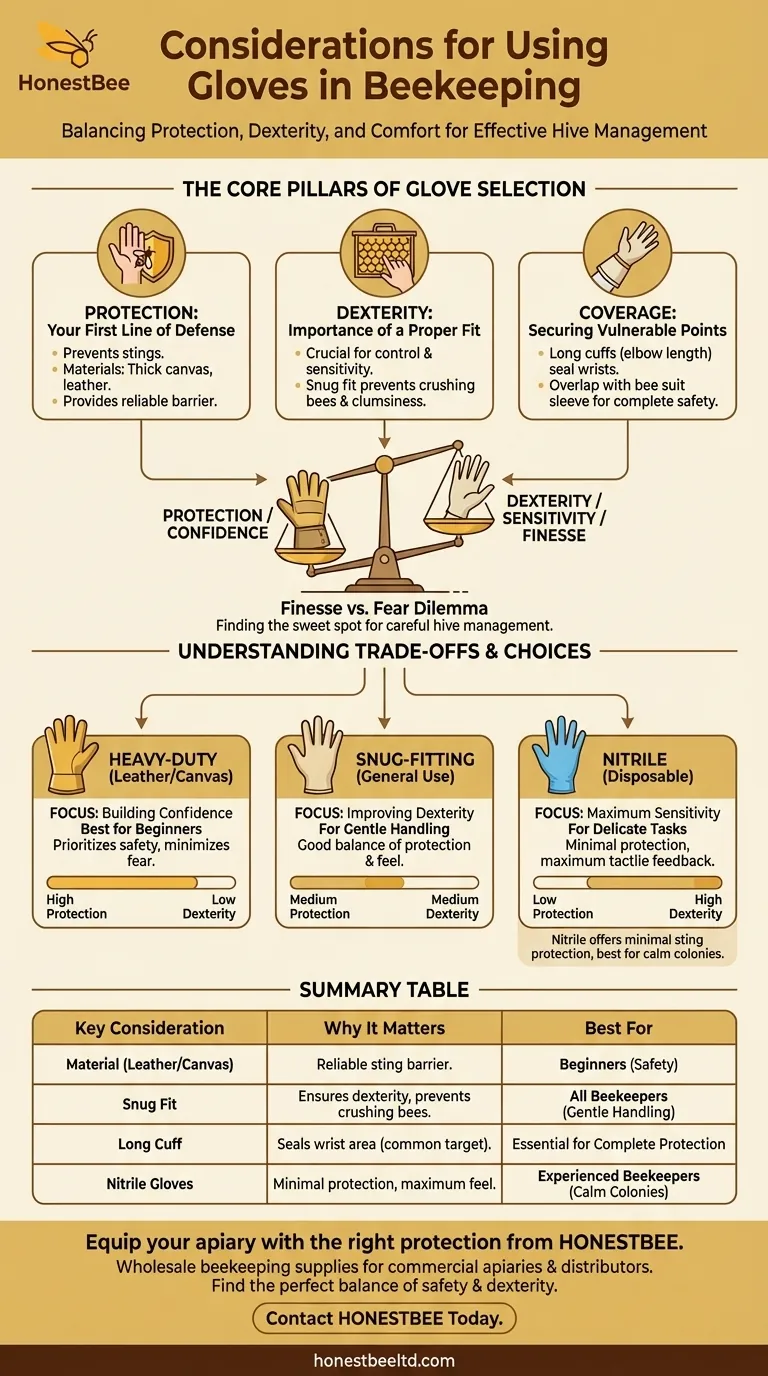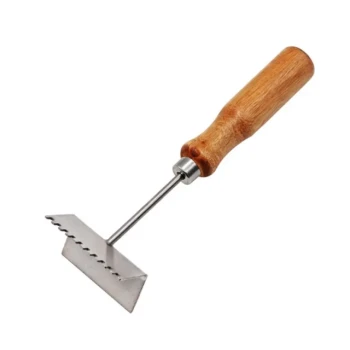The primary considerations for using gloves in beekeeping are the material, fit, and cuff length. These three factors directly influence your level of protection from stings, your dexterity when handling frames, and your overall comfort. The right glove strikes a critical balance between keeping you safe and allowing you to work gently and effectively with your bees.
The central challenge in selecting beekeeping gloves is finding the sweet spot between necessary protection and the tactile sensitivity, or "finesse," required for careful hive management. Your choice reflects a trade-off between feeling secure and handling your bees with a delicate touch.

The Core Pillars of Glove Selection
Choosing the right glove isn't about finding the thickest option available. It's about matching the tool to your experience level and the specific task. An effective choice is based on three fundamental principles.
Protection: Your First Line of Defense
The most obvious reason for wearing gloves is to prevent stings. Your hands are often the closest part of your body to the bees during an inspection.
Materials like thick canvas or leather provide a reliable barrier that a bee's stinger cannot easily penetrate. Thin cotton gloves are generally considered insufficient and can lead to frequent stings.
Dexterity: The Importance of a Proper Fit
A glove's effectiveness is severely compromised if it doesn't fit well. Snug-fitting gloves are crucial for maintaining control and sensitivity.
Gloves that are too loose or have excess material at the fingertips are clumsy. This clumsiness increases the risk of you accidentally crushing bees or damaging delicate honeycomb, which can agitate the colony.
A proper fit also prevents bees from crawling inside the glove at the wrist, a common cause of stings on the forearms.
Coverage: Securing the Vulnerable Points
Bees often target exposed areas like the ankles and wrists. For this reason, beekeeping gloves should have long cuffs that extend well past the wrist.
Ideally, the glove's cuff should reach toward the elbow. You wear the glove first, then pull the sleeve of your bee suit or jacket over the cuff to create a secure, overlapping seal.
Understanding the Trade-offs
While gloves are essential for most beekeepers, especially beginners, it's important to understand the compromises they introduce. This awareness helps you become a better, more gentle beekeeper.
The "Finesse vs. Fear" Dilemma
Some experienced beekeepers argue against wearing thick gloves because they reduce tactile feedback. This lack of "feel" can make it harder to handle frames delicately.
However, for most people, the protection gloves offer provides the confidence needed to move slowly and calmly, which is more important for keeping bees calm than bare-handed sensitivity.
The Nitrile Glove Compromise
As a middle ground, some beekeepers opt for disposable nitrile gloves. These offer a thin layer of protection from getting sticky with honey and propolis while preserving a much higher degree of dexterity than traditional leather or canvas.
Nitrile gloves do not offer significant protection from determined stings, making them a choice better suited for experienced individuals working with calm colonies.
The Risk of a False Sense of Security
Heavy gloves can make a beekeeper feel invincible, leading to faster or rougher movements. Remember that gloves are just one tool; gentle technique and proper use of a smoker are your primary means of preventing stings and keeping the hive calm.
Making the Right Choice for Your Goal
Your ideal glove depends entirely on your comfort level and experience. Use your primary goal as your guide to selecting the right protection for your hands.
- If your primary focus is building confidence as a beginner: Choose thicker leather or canvas gloves with a snug fit to prioritize protection and minimize fear.
- If your primary focus is improving dexterity and hive handling: Select more form-fitting gloves that allow for greater tactile feedback without sacrificing essential sting protection.
- If your primary focus is maximum sensitivity for delicate tasks: You might experiment with heavy-duty nitrile gloves, accepting the trade-off of minimal sting protection for maximum feel.
Ultimately, the best glove is the one that allows you to work confidently, calmly, and gently with your bees.
Summary Table:
| Key Consideration | Why It Matters | Best For |
|---|---|---|
| Material (Leather/Canvas) | Provides a reliable barrier against stings. | Beginners prioritizing safety and confidence. |
| Snug Fit | Ensures dexterity and control, prevents crushing bees. | All beekeepers seeking gentle hive handling. |
| Long Cuff | Seals the wrist area, a common target for stings. | Essential for complete protection; pair with bee suit sleeve. |
| Nitrile Gloves | Offers minimal protection but maximum tactile sensitivity. | Experienced beekeepers with calm colonies. |
Equip your apiary with the right protection from HONESTBEE.
Choosing the right gloves is just one part of effective hive management. At HONESTBEE, we supply commercial apiaries and beekeeping equipment distributors with high-quality, durable beekeeping supplies designed for professional use. Our wholesale-focused operations ensure you get the reliable gear you need to protect your investment and work confidently.
Let us help you find the perfect balance of safety and dexterity for your operation. Contact HONESTBEE today to discuss your equipment needs!
Visual Guide

Related Products
- Vented Beekeeping Jacket with Hood and Veil for Beekeepers
- 3 Layer Mesh Vented Sting Proof Beekeeping Suit with Hat and Veil
- Cotton Beekeeping Suit and Round Hat with Veil Bee Keeper Protective Gear
- Yellow Plastic Bucket Pail Perch for Beekeeping
- Heavy-Duty Stainless Steel Clip-On Frame Perch
People Also Ask
- Why is it important to close all zips and fasten buttons before washing a beekeeping suit? Protect Your Suit & Your Safety
- Why is a jacket with a hat veil recommended for beekeepers? Essential Protection for Your Face and Neck
- What are the advantages of reinforced stitching and durable zippers in beekeeping suits? Ensure Maximum Safety & Longevity
- What should be considered regarding the color of beekeeping clothing? Ensure Your Safety and Keep Bees Calm
- What are the benefits of a fully ventilated beekeeping suit? Stay Cool and Protected in Hot Climates



















